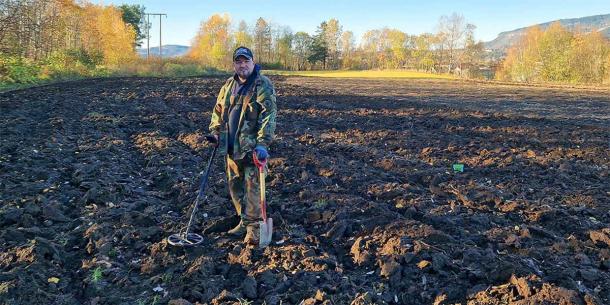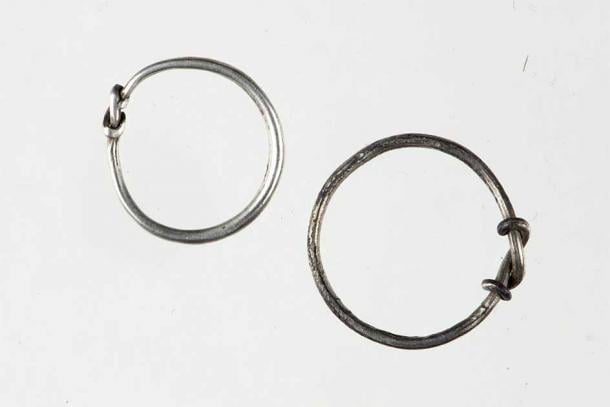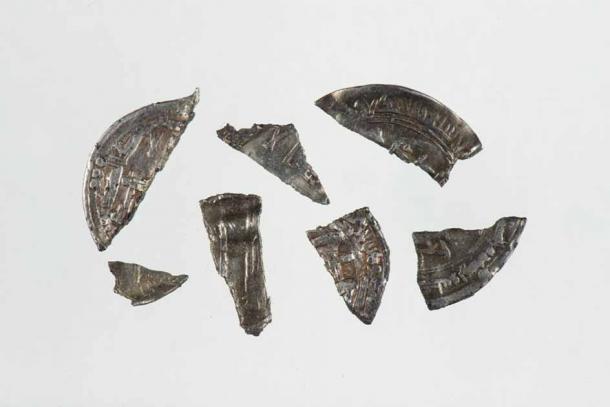
Large Stash of Viking Silver Found in Central Norway
A rare collection of silver objects believed to be from the Viking Age (8th-11th century) has been discovered in central Norway’s Stjørdal, near Trondheim. Buried barely a few centimeters below the ground, the hoard consists of as many as 46 objects, all silver. Only two finger rings are intact while the rest are fragments of coins, bracelets, and other jewelry.
The discovery was made by Pawel Bednarski, an amateur metal detectorist, just before Christmas last year, reports Gemini.no. It was a chance discovery by him, using a spell of good weather to indulge in one of his pastimes. He had no expectation of making such an important find.
Bednarski found the two rings first and then kept pulling out more and more objects till he had a total of 46 items buried barely between two and seven centimeters ( 1 and 3 inches) below the ground, according to Life in Norway.
“The first thing I found was a small ring, which at first glance did not look particularly interesting. Then another ring appeared. And then a piece of a bangle. The objects were covered in clay, so it was not so easy to see what they looked like. It was only when I got home, and rinsed one of the bangle pieces in water, that I realized that this was an exciting find,” he told Gemini.no.
Once he recognized the archaeological significance of the pieces, he contacted the archaeological experts at the county municipality and submitted the find to them.
- Rogue Metal Detectorists Stole $3.6 Million Treasure
- Stunning Medieval Treasures Discovered in Wales By Metal Detectorists

Pawel Bednarski made the discovery of his life with a metal detector in Stjørdal, Norway. (Frid Kvalpskarmo Hansen / gemini.no)
The Viking Silver Hoard is Unusual on Several Counts
The find consists of as many as 46 hack silver objects and is unusual for Norway on several counts. Hack silver is pieces of cut and broken silver items used as currency by weight in times of antiquity. Silver objects were deliberately cut into pieces of different sizes and weights, serving like coins of different values.
There were only two whole finger rings in the stash while the rest were broken fragments of Arab coins, bracelets, a braided necklace, chains and wire. Curiously, according to the History Blog, unlike other hoards of hack silver found in Scandinavia that consist of single pieces from different larger objects, the Stjørdal cache consists of several pieces from the same objects. For example, there are eight fragments that add up to an almost complete wide, band-shaped bangle.

The two whole finger rings from the hoard. Rings like this are often part of treasure finds, but not commonly found in Viking Age graves. This suggests that they were rather used as means of payment, rather than as jewellery. (Birgit Maixner / Gemini.no)
While the county municipality archaeologists have been able to confirm to Bednarski that he had stumbled on objects from the Viking Age, just how significant the find was became clear only when the NTNU Science Museum entered the picture.
Museum researcher and archaeologist Birgit Maixner told Gemini.no:
“This is a rather exceptional find. It has been many years since such a large treasure find from the Viking Age has been made in Norway. This find is from a time when silver pieces that were weighed were used as means of payment. This system is called the ‘weight economy’, and was in use in the transition between the barter economy and the coin economy.”
- Moon Tear Hunters and the Quest for Ancient Silver
- Desperate, The Tribes of Israel Turned to "Fake Silver"
The Weight Economy: A Transition between Barter and Coin Systems
Coins began to be used in Western and Southern Europe from early as the Merovingian period (around AD 550-800). However, Scandinavia remained an outlier and coins made an appearance there only at the end of the ninth century, in the Late Viking Age. Until the Viking Age, a barter economy prevailed in Scandinavia but by the eighth century, the weight economy became widespread. Obviously, it was much more practical than barter in terms of both ease of transportation and valuation, and made rapid inroads once it was introduced.
To put the actual worth of the Stjørdal silver hoard in perspective, weighing 42 grams in all, they would have allowed the owner to buy 0.6 of a cow. This means the treasure was of considerable value for the time.

Arab coins were the biggest source of silver in the Viking Age, and came to Scandinavia, among other things, through the fur trade. By cutting the coins up, it was easy to give them the desired weight. (Birgit Maixner / Gemini.no)
Arab Coins in the Collection
Arab coins constituted the largest source of silver in Scandinavia in the period, arriving in the region as part of the fur trade. The Stjørdal find also contains Arab coins.
Four of the seven coins found in the collection have been dated. Surprisingly, they date to the 8th century, earlier than most other Arab coins found in Norway.
“The relatively old age of the Islamic coins, style of bracelets and the large degree of fragmentation of most of the objects is more typical of treasure finds from Denmark than from Norway. These features also make it likely to assume that the treasure is from around 900 AD,” Maixner told Gemini.no.
Why Was Such Valuable Treasure Buried?
Why the owner chose to bury a silver hoard of so much value can only be a matter of speculation. Earlier finds of silver and Viking Age coins indicate that the area was a trading post. A Viking Age grave found at a nearby farm contained a bowl scale used to weigh silver, further substantiating that trading activities took place here.
“Perhaps the owner of the silver treasure found the trading post unsafe and hid their valuables in the entrance area to the plain. Here it remained for about 1,100 years,” said Maixner according to Life in Norway.
Whatever is the case, it has been the find of a lifetime for Bednarski, who said, “Fantastic! I have never made a similar discovery, something like this you only experience once.”
Top image: The Viking silver hoard from Stjørdal, Norway consists of a total of 46 objects in silver. Source: Birgit Maixner, NTNU Science Museum.
By Sahir Pandey
References
Hansen, F.K. 2022. Sølvskatt fra vikingtid funnet i Stjørdal. Avaialble at: https://gemini.no/2022/10/solvskatt-fra-vikingtid-funnet-i-stjordal/.
Nikel, D. 2022. ‘Exceptional’ Viking Silver Discovery in Central Norway. Available at: https://www.lifeinnorway.net/viking-silver-discovery-norway/?fbclid=IwAR0dnWjZnDCCVGV_TqByP0Wipz1o6E6Iyo4mErm0lRAdUqMMpPv2JE0fvSo.
The History Blog. 2022. Viking hack silver hoard found in Norway. Available at: https://www.thehistoryblog.com/archives/65510.















